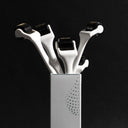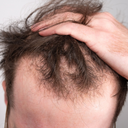The age-old question of whether wearing hats leads to hair loss has generated much debate and curiosity. While our headwear choices reflect our style, could they be inadvertently contributing to hair loss?
This article delves into this intriguing topic, separating fact from fiction, and providing useful insights for the fashionably conscious and health-aware.
See how to manage your hair loss naturally
Table of content
Does wearing a hat cause hair loss?

Many people believe that regularly wearing hats could lead to hair loss, but is there truth to this?
Let us clear the air. No, wearing a hat does not cause hair loss, not directly.
Scientific studies, such as the one conducted by James Gatherwright and colleagues in 2013, have explored various factors contributing to male alopecia but haven't established a direct causal link between hat wearing and hair loss.
As your leading source for hair health information over the past 4 years, we never compromise on accuracy. When it comes to your health, you deserve information you can truly rely on - and earning your trust is our top priority.
Here's how Scandinavian Biolabs ensures every piece of content meets the highest standards of accuracy and integrity:
- Credentialed Experts: Our reviewers are actively practicing doctors and medical researchers
- Stringent Reviews: Content undergoes rigorous editing by subject specialists and review by a practicing doctor.
- Evidence-Based: We rely on well-established research from trusted scientific sources like peer-reviewed journals and health authorities.
- Full Transparency: Our editorial standards, writer credentials, reviewer credentials, correction process, and funding are all publicly documented.
- Independent Voice: While we do promote products, we operate in a vacuum to business operations. Our main goal is just an unwavering commitment to providing medically-sound guidance.
You can count on Scandinavian Biolabs to consistently deliver the trustworthy health information you deserve. Read our Editorial Standards.
What does science say on hat and baldness?
Although we need to assess many factors, in the end, it depends on the person wearing the hat. There is a lack of scientific studies regarding this issue.
However, there has been one notable piece of research that can help us conclude if hats do cause baldness.
The research uses quantitative methods by using questionnaires, pictures, and other biological measures to assess if hats were a cause for baldness. Subjects of this study were 92 identical twins who could be the closest thing to being genetically identical.
Each identical twin's data was compared to the other to identify external factors, outside of genetic predisposition, which contributed to hair loss or baldness.
Investigating identical twins made it easy for them to exclude genetic factors and focus on the external factors. The results proved that hat does not contribute to hair loss but can help decrease temporal hair loss.
Temporal alopecia is a genetic type of hair loss often referred to as the receding hairline that many men will be familiar with.
If anything, the aforementioned study emphasizes that genetic and environmental factors play a more substantial role in hair loss. Factors like smoking duration, dandruff presence, and testosterone levels were more significantly associated with hair loss patterns than hat usage.
Why do hats cause your hair to fall out?
People believe that if you are predisposed to male pattern hair loss, wearing a hat will worsen it. We came across some reasons that would be leading to such speculation.
- Tight Hats and Circulation: Wearing overly tight hats could potentially affect blood circulation to the scalp, but this is unlikely to cause significant hair loss.
- Sweat and Hygiene: Non-breathable materials in hats can increase sweating, potentially clogging hair follicles. However, this typically leads to temporary and reversible hair loss.
- Friction and Traction: Constant friction or traction from tight hats might contribute to hair breakage or damage, but again, it's not a primary cause of hair loss.

How to avoid hair loss while wearing hats?
To enjoy hats without worrying about hair health, consider the following tips:
- Choose Breathable Materials: Opt for hats made from natural, breathable fabrics to reduce sweat accumulation.
- Ensure Proper Fit: Avoid too tight hats that can cause unnecessary pressure or friction.
- Maintain Hat Hygiene: Regularly clean your hats to prevent bacterial buildup that could irritate the scalp.
How to regrow hair from hat hair loss?
Experiencing hair thinning from frequent hat use? Scandinavian Biolabs Hair Growth Routine is your go-to solution. This natural, effective routine targets and reverses the damage caused by tight hats, promoting stronger, healthier hair.
Why Choose Scandinavian Biolabs?
- Clinically Tested: 93% of the participants had a measured reduction in hair loss.
- Nature-Powered: Bio-active ingredients to nourish and strengthen your hair.
- Easy Integration: Fits seamlessly into your daily hair care routine.
Make the smart choice for your hair's future. Embrace the Scandinavian Biolabs Hair Growth Routine for resilient, revitalized hair, regardless of your hat habits. Start your journey to healthier hair today!
FAQs
READ MORE:
- Low Hairline: Definition, Cause & Treatment
- 8 Effective Ways How To Remove DHT From Scalp
- Does Minoxidil Work For A Receding Hairline?
Reference
- Grant Phillips T, Paul Slomiany W, Allison R II. Hair Loss: Common Causes and Treatment. AFP. 2017 Sep 15;96(6):371–8.
- Gatherwright J, Liu MT, Amirlak B, Gliniak C, Totonchi A, Guyuron B. The Contribution of Endogenous and Exogenous Factors to Male Alopecia: A Study of Identical Twins. Plast Reconstr Surg. 2013 May;131(5):794e.
- Smith A. Traction alopecia: Causes, treatment, and prevention [Internet]. 2018 [cited 2021 Sep 12]. Available from: https://www.medicalnewstoday.com/articles/320648







